
Purchase Tickets
Let’s Talk About Paper II
September 6, 2011
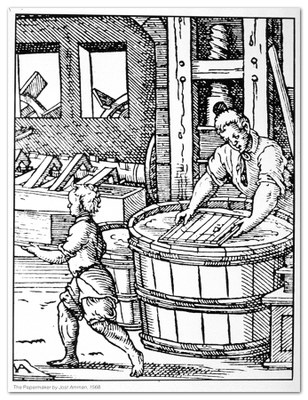
Paper was invented in China where they had their own methods, but most historic papers in North America come from the tradition of hand papermaking that was present in Europe. Large vats of cotton and linen fibers suspended in water were stirred up, and a frame called a mould was dipped in the slurry. The frame was leveled, drained, pressed, and the resulting sheet was allowed to dry.
This is example is from the IHS collection:
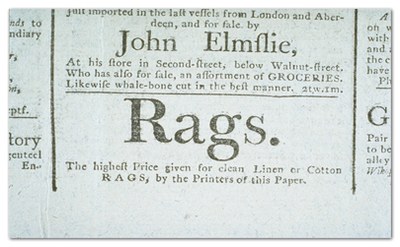
This is a detail of an advertisement printed in a newspaper from the 1700s. Cloth rags were shredded and beaten to create a slurry that was used to make the paper. This example is in really great condition because cotton and linen handmade papers are very stable.
This is another example of paper:
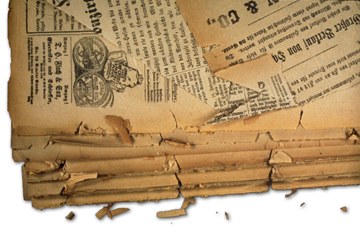
With the industrial revolution of the mid 1800s came the introduction of machine made papers. But this technology could not handle cotton or linen fibers because they were too long. They had to rely on fiber of a different kind – short fibered wood cellulose from trees. Trouble is, wood cellulose contains highly reactive acids called lignin. This sample shows how the acids have degraded the paper. It is brittle, yellow and has no flexibility or strength. Any movement can lead to tatters or complete fracture. What kinds of paper in your family collection most closely resemble these? Somewhere in between? Wait, there’s more.
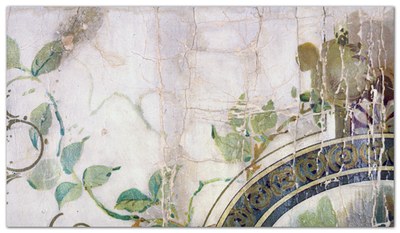
Clay-coated papers are coated with a layer of clay to improve the appearance of poor quality papers and make a nice printing surface. The above example exhibits typical cracking of the fragile clay layer and abrasion. Clay gets slippery when wet, so these coatings are soluble in water, and whatever is printed on them can actually just dissolve away!
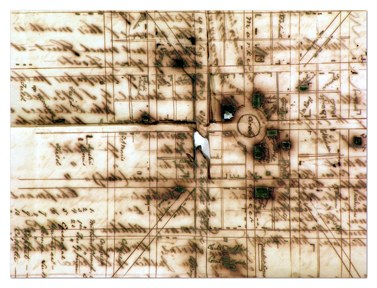
Many early inks were made at home, and the recipes vary in how they were made. Iron gall ink used shavings of iron combined with vitriol or ferrous sulfate. The ink is actually very pale when freshly made, so if someone needed to use it right away, they?d mix in berry juice or a dye, like woad, to color it. The ink eventually turns brown when exposed for a while to oxygen, so the brown shades of ink you see in early manuscripts are oxidized iron gall ink. Too much iron used in the recipe produces a very acidic ink though and often causes the paper to split right where the ink is laid on the paper. This is referred to as lacing? because entire sheets of paper can look like lace once the acidic reaction is complete.
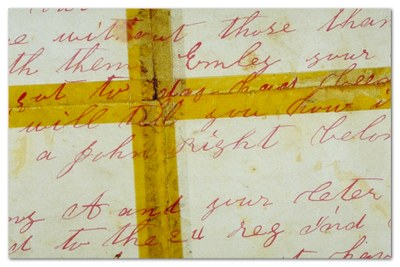
All collections present their own set of problems, but basic to most family collections is the previous use of tape to mend splits and tears in the paper. Tape is really unstable, meaning it will breakdown in time. The adhesives get yellow, stickier and flow through the paper (leaving a disastrous mess) and actually weaken and stain the paper it was meant to help save. For this reason, tapes are like the plague for conservators because we have to use some pretty toxic solvents to safely remove it. So play nice, and don?t use tape to mend paper. Instead, come to the Indiana Historical Society and learn how conservators mend paper with lightweight Japanese tissue paper and wheat starch paste. You can try it in the History Lab, and if you like saving history, you will like this I promise!

Whenever you start an important project, like saving your family history, it?s best to just set aside an adequate, clean workspace without any clutter. Music is fine, but keep your hands clean and avoid food and drink in the area to prevent accidental spills. (Just when you put your cup down on your worktable your cat will want to be your center of attention. Connect the dots.)
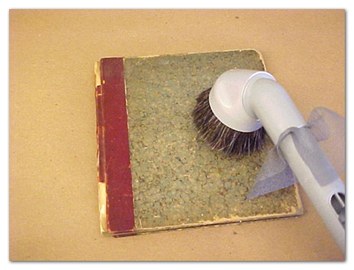
If your hands feel grit or soot on the surface of things, just vacuum them very carefully before surfaces are disturbed. This will prevent soil from being transferred from one item or bundle to the next. Wiping surfaces with a cloth will probably drive the dirt into the paper, so be careful if you try it. Look at the picture where the brush is attached to the vacuum hose. This is a six-inch cut square of nylon window screening placed over the hose opening before the brush is attached. The screen is there to catch any particle that might be loose on the surface, like a seal or a bit of leather. If your vacuum is too strong, use a wide soft bristled paint brush to gently brush fragile surfaces.
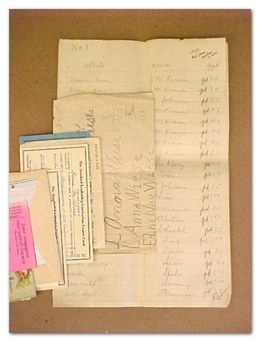
If you have a LOT of stuff (and some people do) take time to determine if there is an order of some sort. This will help you organize a large collection, and maybe you can use that order or decide on one of your own. Little tags or slips of paper can be important too, so be aware of any that might have some important information like names, places or dates. Take the time to examine the entire collection to determine the condition, the size of items and anything of special significance. It will come in handy later.
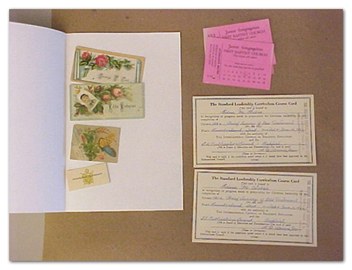
If you have things that should be stored together do not submit to the stapler! Staples rust eventually. Just put them inside a fold of a good-quality paper or an acid-free archival paper. These papers (called Perma-Life) are available at archival supply houses like Conservation Resources Ltd. or University Products. They?re on the web.
Little bundles like these or letters inside envelopes that retain sharp creases need to be gently unfolded so they can be stored flat.
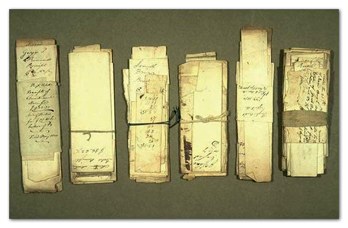
If the paper is so brittle that it does not unfold with ease or causes splitting you may have to humidify the papers a bit. It?s easy. Lay the papers out on nice clean toweling the next time you take a steamy shower and let the papers naturally absorb the moisture. Cover with another clean towel and a sheet of plastic to help the paper relax. Check it after a few hours in this spa and the paper should be a bit more relaxed. Never give in to the temptation to spray water on the paper. If the inks are soluble, you will have ruined the item. If you find the papers need another gentle spa, follow the directions like the first time and check again. Once they are fully relaxed, place a dry towel on top until perfectly dry.
If you really want to go all out you can create an inventory and classify items. This can be helpful when you pass these along to another family member. Just think of it in 100 years someone will say ,Thank goodness Aunt Melissa or Uncle Jason did that inventory or we?d be sunk!? So be a hero if you want! Things can be classified as handwritten manuscripts, printed certificates, receipts, account books, diaries, etc. They can be distinguished by including the name on the document and/or the date. This list can supply logical titles for the folders that will eventually contain each type of item.
At the end of the inventory, you can sum up the info to describe the collection. James Madison Whatnot lived with his family in Bean Blossom in 1875. This collection documents his family and business.? Recollections from older family members can be used to help round out details, of course, but if anyone can positively identify people, places and things with proof that is great. That?s called “provenance,” and an example of this may be a receipt from a family member?s attic that connects a name to a particular artifact or book.
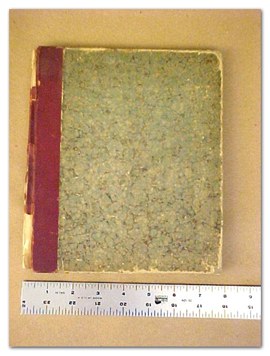
During the inventory, take note about the size and condition of things just so you know how big a box or series of boxes you?ll need to store all the collection. You?ll have to order some good-quality archival supplies at some point, and knowing the dimensions of the oddly sized things will be useful and help you budget a bit for your project.
A little reminder here as you go through, take time to notice the condition of things and handle them with care. Whatever you do, don?t apply tape to tears. Do I have to show you the tape image again? OK I will:
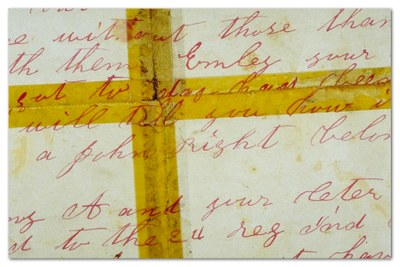
ALL tapes (even those they call archival?) will eventually change and damage the paper. We are starting to receive collections from those who have used archival tape they leave an oily stain after as little as 10 years. Not so good.
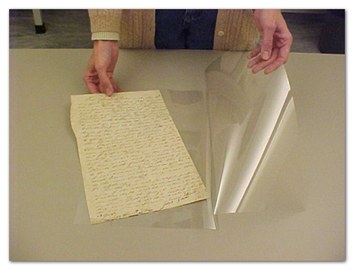
When you find an item in poor condition, provide support for it with a Mylar or polyethylene sleeve. This will help keep fingerprints off the paper but will reduce the chances of further damage as well. Now the pitch: If the item is significant, consider contacting a conservator and getting some advice. Tapes, for instance, need to be removed or the paper will eventually turn transparent from the adhesive. Only a professional working safely with a selection of solvents can really do this, so kids, don?t try this at home and stay away from tape.
____________________








